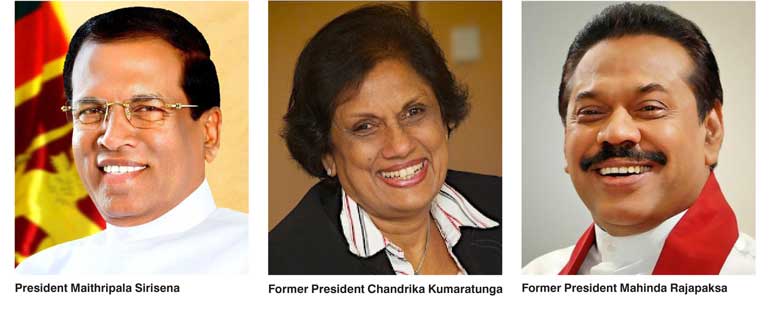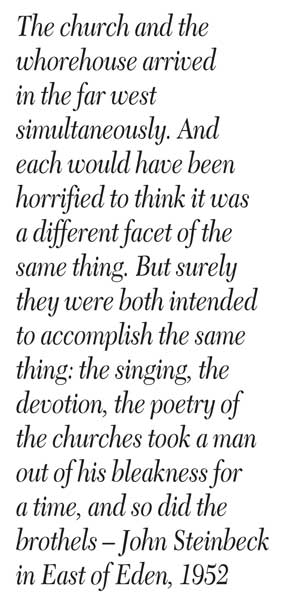Sunday Mar 09, 2025
Sunday Mar 09, 2025
Wednesday, 31 August 2016 00:01 - - {{hitsCtrl.values.hits}}

 Listening to President Maithripala Sirisena at the Matara rally threating to reveal secrets of the Joint Opposition, instinctively I recalled this exquisitely emblematic confluence of the benign and the bawdy that Steinbeck describes in his novel ‘East of Eden’. It was Steinbeck’s greatest work in which he explores the good and evil in the human condition.
Listening to President Maithripala Sirisena at the Matara rally threating to reveal secrets of the Joint Opposition, instinctively I recalled this exquisitely emblematic confluence of the benign and the bawdy that Steinbeck describes in his novel ‘East of Eden’. It was Steinbeck’s greatest work in which he explores the good and evil in the human condition.
Steinbeck saw the confused world as a poem, a habit or dream. Sen though a peep hole its inhabitants were “whores, pimps, gamblers and sons of bitches,” by which he meant everybody. Seen through a different peep hole they could be “Saints and angels and martyrs and holy men.” Since it is the same eyes seeing through different peepholes they were ‘the same thing’.
The President’s exhortations at Matara on corruption committed and corruption that is likely to be happening presented me and my fellow citizens the same conundrum seen through Steinbeck’s two different peepholes.
The Matara display of popular support was to mark the first year anniversary of aimless meandering interspersed with some positives by the UNP-SLFP Parliamentary coalition. Their first year balance sheet is short of positive gains but registers some amelioration of earlier mayhem, tyranny and fleece.
Ground reality
A few days earlier, the nation watched the audacious attempt of Upul Jayasuriya, the boss of BOI, reaching for a pie in the sky. President Sirisena he claimed would go in to history as the Mandela of Sri Lanka. His Zulu dance was performed at the Law Asia confab held in Colombo. It seems that we are definitely narrowing the gap between sanctity and profanity in political discourse.
Sycophancy or adulatory superlatives cannot camouflage the ground reality of a Government under siege economically and politically. It is the poor, make believe Mandela who bears the brunt of the negative public perceptions. It is President Sirisena who has to appease public discontent over a sluggish economy and worsening living costs. In times of scarce resources he has the unenviable role of the proverbial harlot – responsibility with no authority.
He does not decide on priorities. His Prime Minister with an elite coterie determines priorities. He then keeps revising them, dismantling the great myth of Ranil the technocrat. The stock response of the Government today is ‘we may not have achieved all that was promised but we are certainly better than them.’ A sceptical public refuses to buy that line because the kleptocratic elite remains in command of the decision making process.
In effect we live in a post factual democracy where there seems to be a shadowy collusion between the ousted Rajapaksa camp and a powerful UNP coterie pursuing an agenda of its own. They are both sliding towards this post factual democracy by common consent. The signs are there for anybody who bothers to look closely.
The main UNP spokesmen have remarkably excelled in reducing their policy programs to slogans. They now pay only lip service to their original vision. The MR-led Joint Opposition has developed a genius to make up any shit however implausible if such would help tide over their immediate hurdles.
 The Prime Minister’s open taunt of Joint Opposition provocateur Wimal Weerawansa of favoured treatment he sought is philistine at best and nauseating at worst. The 200% proof demanded before charges are framed and indictments filed coupled with exceedingly slow grinding of the wheels of justice are a part of the post factual democracy.
The Prime Minister’s open taunt of Joint Opposition provocateur Wimal Weerawansa of favoured treatment he sought is philistine at best and nauseating at worst. The 200% proof demanded before charges are framed and indictments filed coupled with exceedingly slow grinding of the wheels of justice are a part of the post factual democracy.
Sirisena vs. Rajapaksa
In mob oratory, President Sirisena is no match for his opponent Mahinda Rajapaksa. He is not a mercurial orator. Mahinda Rajapaksa is mercurial and more. He exhorts his listeners to trust his proven expertise and demonstrated authority.
In contrast, Maithripala Sirisena in his sage, measured Presidential tone, resorts to illustrations, narratives and facts. Mahinda appeals to emotions. Maithri pleads for ethical propriety. The two antagonists are locked in battle for prescriptive rights over the Sri Lanka Freedom Party. Pathos versus Ethos. Logos is nowhere to be found. No wonder the people are in a state of incredulous confusion!
Today’s broad debate between the two groups battling for control is not about the SLFP – the political party. It is about the structural convenience that evaded the grasp of President Sirisena immediately after 8 January 2015. That failure helped the dislodged President to augment his formidable economic clout with discernible political muscle. A position that suited the UNP.
In his 10 years of untrammelled power, Mahinda Rajapaksa did to the SLFP in particular and to multi-party discourse in general what the Ottomans did to the Balkans. He entrenched a patriarchy. He made corruption systemic. He made the Judiciary a servile agency. Above all he embedded a political and financial elite that is not easy to dismantle.
A few months ago, the President was the attesting witness at the wedding of the son of a Ministry Secretary who is fortunate to retain his influence and mastery under the new dispensation. He is the archetypal Rajapaksa apparatchik. Rural peasant origins. Excellent academic background. Steady advancement in public service. In a land where flaunting unaccounted wealth is no crime he thrived under the benign grace of the patriotic regime. The proud father told guests at the wedding that the young couple would honeymoon in Europe and the price tag was around Rs. 2 million. It hurts. He is not Zuckerberg who made millions with software. Nobody makes that kind of money by saving on electricity and cycling instead of driving.
What the Matara rally demonstrated was that the institution called the political party does not occupy centre stage in discursive politics. The public is increasingly inclined to decide their political allegiance on the basis of personalities instead of parties. The demand for two ballot papers – one for the candidate and the other for the party is more than adequate evidence of public disenchantment with the choice of candidates by parties.
The only role of the party in today’s context is that it provides the enabling frame work for recruiting political leaders at grass roots. It goes without saying that close affiliations and a history of connections through family is a sine qua non to be processed in the conventional party system.
Roots of evil: President J.R.J.’s changes
But the Rajapaksa tribe are not the primary villains. The roots of evil can be traced to the epochal changes brought about by the lopsided yet decisive mandate of President J.R.J. With five sixth of seats in Parliament he kept to his promise and rolled up the electoral map with the Referendum of 1982. The Referendum of 1982 was a gang rape of democracy planned by the party that claims to be the party that negotiated our independence.
President Jayewardene then proceeded to do something that totally undermined the multi-party parliamentary democracy. Presiding as Zeus in his throne atop Olympus he unleashed and presided over a shadowy war among the lesser gods Ranasinghe Premadasa, Lalith Athulathmudali and Gamini Dissanayake. Each Minister launched his exclusive gravy train. The Gam Udawa, the Mahapola, and the Mahaweli were grand triumphal marches in the tradition of the vulgar opulence of corrupt Rome. They were populist pageantry at tax payer’s expense. The purpose was to propel each one of them as ‘capo de tutti capi’ in their respective camps in to prominence.
The giant billboards announcing development initiatives with huge silhouettes of the patron which became an exclusive art form under MR has its genesis in the grand plan of the Jayewardene Government. It had its funny and disgraceful episodes too. Both the President and Prime Minister accompanied by their wives attended the Charles and Dianna wedding at West Minster Cathedral. Profligacy is not a Rajapaksa discovery. If at all they fine-tuned it to an art form.
The political trajectories of the three prominent aspirants to the executive presidency in the JRJ cabinet is contemporary history. Yet do they not remind us of the victors and vanquished at the Battle of Pharsalus. Did it not lead one to the pinnacle of power and then to the beyond, spelling the end of the Republic? President Wijetunge was an exception. His altruistic presidency was as exceptional as the circumstances that propelled him to office.
Presidency of Chandrika Kumaratunge
One could find many faults in the Presidency of Chandrika Kumaratunge. Just as her imperious father, she frowned on petty corruption but allowed them to pass as permissible indulgences of the hoi polloi. Of course, there were some glaringly revolting indulgences.
Chandrika has not been recognised for her genuine attempts at Constitutional reforms in 2000. One could blame her for not attempting it earlier in her first term. It is the Ranil Wickremesinghe-led UNP that undermined her democratic reforms. Hers was a regime that suffered and tolerated ordinary corruption. If there was corruption it was corruption in stealth. Not corruption with impunity. The Day light robberies came after her term when the CJ chosen on the recommendations of the Hunch Back of All Souls told her that the six-year term commenced from the day she was elected for her second term.
President Chandrika Kumaratunge through her two terms was torn between assertive governance – the first imperative of the executive presidency and her inherently Bohemian ‘vision du monde’ that was natural to her and her late husband Vijaya. Perhaps the frequent soirées on the left bank made her indifferent to the mechanics of power. Of all executive Presidents of the past her presidency was exceptionally devoid of planned and deliberate abuse or misuse of power.
Power dynamics
Of the two major political parties, the UNP is institutionally resilient and can resist external raids. More than a party, the UNP is a cooperative of the power elite. It is a political conglomerate made of several interest groups. If some of them found refuge under the Rajapaksas they have now returned to the fold. If some of them withdrew to the margins under Premadasa rule, they patiently bided their time to surface when appropriate.
The present power dynamics of the SLFP come as no surprise. It is the party that is worth fighting for. Other than the JVP which is yet to break loose from its doctrinaire rigidity and the minority parties, the SLFP remains the party that holds political promise. Nobody knows it better than Comrade Vasu and Dinesh, the son of Philip.
The SLFP is the only political group that exists in the psyche of the majority community with the semblance of a political party capable of mass mobilisation. The SLFP, thanks to its two formative leaders, Solomon and Sirimavo, produced an ill-defined ideology of selective socialism. Shepherded by a manor born elite portraying a ‘Siddhartha’ type renunciation captured the imagination of the native elite suffocating under the comprador class.
It would not have survived but for the peasant ideology of T.B. Illangaratne politician, novelist and trade unionist. He was a Sri Lankan combination of C.P. Snow and Stafford Cripps. This peasant from Thumpane wittingly or unwittingly etched the SLFP in the social conscience of the majority community. There is no doubt that Illangaratne who had the good fortune of assembling a team of nativist academics and bureaucrats of the calibre of G.V.S. De Silva, Jayantha Kelegama, P.B. Karandawela and Charles Abeysekera, to name a few made the Sri Lanka Freedom Party the ‘structural metaphor of Lankan society and the cultural understanding of the nation’.
When Chandrika persuaded Maithripala Sirisena to challenge Mahinda Rajapaksa, she was an instrument of history. She was a determined pilgrim who wished to cleanse a defiled shrine. I know I will be much reviled for saying this. I wish Chandrika Godspeed in the task ahead.
Discover Kapruka, the leading online shopping platform in Sri Lanka, where you can conveniently send Gifts and Flowers to your loved ones for any event including Valentine ’s Day. Explore a wide range of popular Shopping Categories on Kapruka, including Toys, Groceries, Electronics, Birthday Cakes, Fruits, Chocolates, Flower Bouquets, Clothing, Watches, Lingerie, Gift Sets and Jewellery. Also if you’re interested in selling with Kapruka, Partner Central by Kapruka is the best solution to start with. Moreover, through Kapruka Global Shop, you can also enjoy the convenience of purchasing products from renowned platforms like Amazon and eBay and have them delivered to Sri Lanka.
Discover Kapruka, the leading online shopping platform in Sri Lanka, where you can conveniently send Gifts and Flowers to your loved ones for any event including Valentine ’s Day. Explore a wide range of popular Shopping Categories on Kapruka, including Toys, Groceries, Electronics, Birthday Cakes, Fruits, Chocolates, Flower Bouquets, Clothing, Watches, Lingerie, Gift Sets and Jewellery. Also if you’re interested in selling with Kapruka, Partner Central by Kapruka is the best solution to start with. Moreover, through Kapruka Global Shop, you can also enjoy the convenience of purchasing products from renowned platforms like Amazon and eBay and have them delivered to Sri Lanka.